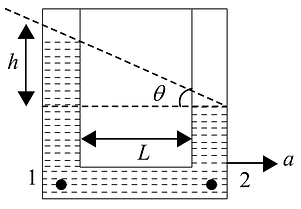Assume that a drop of liquid evaporates by decrease in its surface energy, so that its temperature remains unchanged. What should be the minimum radius of the drop for this to be possible? The surface tension is $T$, density of liquid is $\rho$ and $L$ is its latent heat of vaporization.
- $\rho L/T$
- $\sqrt{T/\rho L}$
- $T/\rho L$
- $2\,T/\rho L$
The Correct Option is D
Solution and Explanation
Top Questions on mechanical properties of fluid
If 1000 droplets of water of surface tension 0.07 N/m, having same radius 1 mm each, combine to from a single drop In the process the released surface energy is - (Take π=\(\frac {22}{7}\))
- JEE Main - 2023
- Physics
- mechanical properties of fluid
- As shown in the figure, a liquid is at the same levels in two arms of a U-tube of uniform cross-section when at rest. If the U-tube moves with an acceleration 'f' towards the right,the difference in liquid heights between the two arms of the U-tube will be,(acceleration due to gravity=g)

- WBJEE - 2023
- Physics
- mechanical properties of fluid
- The surface of water in a water tank of cross section area $750\, cm ^2$ on the top of a house is $h m$ above the tap level The speed of water coming out through the tap of cross section area $500 mm ^2$ is $30\, cm / s$ At that instant, $\frac{d h}{d t}$ is $x \times 10^{-3}\, m / s$ The value of $x$ will be ____
- JEE Main - 2023
- Physics
- mechanical properties of fluid
- A Spherical ball of radius $1 \,mm$ and density $10.5\, g / cc$ is dropped in glycerine of coefficient of viscosity $9.8$ poise and density $1.5 \,g / cc$ Viscous force on the ball when it attains constant velocity is $3696 \times 10^{-x} N$. The value of $x$ is_______.
(Given, $g=9.8 \,m / s ^2$ and $\pi=\frac{22}{9}$ )- JEE Main - 2023
- Physics
- mechanical properties of fluid
- A fully loaded boeing aircraft has a mass of $5.4×10^5 $ kg. Its total wing area is $500 m^2$. It is in level flight with a speed of 1080 km/h. If the density of air 𝜌 is $1.2 kg m^{−3}$, the fractional increase in the speed of the air on the upper surface of the wing relative to the lower surface in percentage will be. ($𝑔=10 m/s^2$)
- JEE Main - 2023
- Physics
- mechanical properties of fluid
Questions Asked in JEE Main exam
- Let \[\vec{a} = \hat{i} + \hat{j} + \hat{k}, \quad \vec{b} = -\hat{i} - 8\hat{j} + 2\hat{k}, \quad \text{and} \quad \vec{c} = 4\hat{i} + c_2\hat{j} + c_3\hat{k} \]be three vectors such that \[\vec{b} \times \vec{a} = \vec{c} \times \vec{a}.\]If the angle between the vector $\vec{c}$ and the vector $3\hat{i} + 4\hat{j} + \hat{k}$ is $\theta$, then the greatest integer less than or equal to $\tan^2 \theta$ is:
- JEE Main - 2024
- Vector Algebra
- 10 mL of gaseous hydrocarbon on combustion gives 40 mL of CO\(_2\)(g) and 50 mL of water vapour. The total number of carbon and hydrogen atoms in the hydrocarbon is ______ .
- JEE Main - 2024
- Hydrocarbons
- If each term of a geometric progression \( a_1, a_2, a_3, \dots \) with \( a_1 = \frac{1}{8} \) and \( a_2 \neq a_1 \), is the arithmetic mean of the next two terms and \( S_n = a_1 + a_2 + \dots + a_n \), then \( S_{20} - S_{18} \) is equal to
- JEE Main - 2024
- Arithmetic Mean
A body of mass 1000 kg is moving horizontally with a velocity of 6 m/s. If 200 kg extra mass is added, the final velocity (in m/s) is:
- JEE Main - 2024
- speed and velocity
- $\textbf{Choose the correct statements about the hydrides of group 15 elements.}$
A. The stability of the hydrides decreases in the order \(\text{NH}_3 > \text{PH}_3 > \text{AsH}_3 > \text{SbH}_3 > \text{BiH}_3\)
B. The reducing ability of the hydrides increases in the order \(\text{NH}_3 < \text{PH}_3 < \text{AsH}_3 < \text{SbH}_3 < \text{BiH}_3\)
C. Among the hydrides, \(\text{NH}_3\) is a strong reducing agent while \(\text{BiH}_3\) is a mild reducing agent.
D. The basicity of the hydrides increases in the order \(\text{NH}_3 < \text{PH}_3 < \text{AsH}_3 < \text{SbH}_3 < \text{BiH}_3\)
Choose the most appropriate from the option given below:- JEE Main - 2024
- p -Block Elements
Concepts Used:
Mechanical Properties of Fluid
The science of the mechanical properties of fluids is called Hydrostatics. A fluid is a substance that relents to the slightest pressure. Fluids are categorized into two classes famed by the names of liquids, and elastic fluids or gases, which later comprehend the air of the atmosphere and all the different kinds of air with which chemistry makes us acquainted.
Streamline Flow:
A streamline is a curve the tangent to which at any point provides the direction of the fluid velocity at that point. It is comparable to a line of force in an electric or magnetic field. In steady flow, the pattern of the streamline is motionless or static with time, and therefore, a streamline provides the actual path of a fluid particle.
Tube of Flow:
A tubular region of fluid enclosed by a boundary comprises streamlines is called a tube of flow. Fluid can never cross the boundaries of a tube of flow and therefore, a tube of flow acts as a pipe of the same shape.
Surface Tension and Viscosity:
The surface tension of a liquid is all the time a function of the solid or fluid with which the liquid is in contact. If a value for surface tension is provided in a table for oil, water, mercury, or whatever, and the contacting fluid is unspecified, it is safe to consider that the contacting fluid is air.



